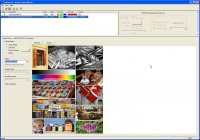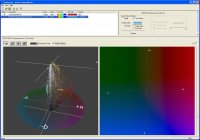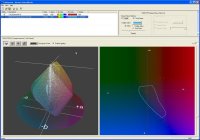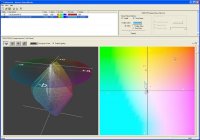- Thread starter
- #11
- Joined
- Dec 20, 2010
- Messages
- 978
- Reaction score
- 1,007
- Points
- 233
- Location
- Ottawa, CANADA
- Printer Model
- Canon Pro-100, and Epson 3880
As the Chinese proverb says: The first step towards progress is calling things by their proper name.
The statement below confuses the differences between color models (RGB/CMYK,CIELAB) and gamuts!
Adobe RGB(1998) and sRGB are both RGB color spaces (specifically Working Spaces), they have differing color gamuts
Forget this notion about millions of colors. You can't see anything like that number, and if you can't see them, they are certainly not colors.
It's marketing hype.
What you may be alluding to is:
Adobe RGB (1998) and sRGB, ProPhoto RGB are just color spaces, or rather containers. They don't inherently have any information other than specifications for primaries, white point, and gamma. Until we actually have a pixel, they don’t contain any information. The pixel has an encoding value which can provide a number of possible device values. For example, 24 bit color, (three channels, 8-bit each) can mathematically define 16.7 million device values.
The point is, we can use math to produce a value that has no actual relationship to what we can see and call color. Our computers do not manipulate colour, or even have any colour sense. They merely crunch the numbers, that can be converted to colour values depending on the colour model and space or gamut being used.
All the RGB working spaces have exactly the same number of addressable device values and the total number is set by the bit depth of the image file used for encoding, i.e., 8-bit, 16-bit. It is important to note that AdobeRGB has a much larger colour gamut than sRGB, even though it contains EXACTLY THE SAME NUMBER of addressable spaces which is the magical 16.7 million previously mentioned, if encoded in 8 bit.
In a nutshell: The millions of colors are encoding of device values, NOT colors.
Sorry to be such a pain. Please re-read my first sentence.
RS
The statement below confuses the differences between color models (RGB/CMYK,CIELAB) and gamuts!
Adobe RGB(1998) and sRGB are both RGB color spaces (specifically Working Spaces), they have differing color gamuts
"RGB color space or RGB color system, constructs all the colors from the combination of the Red, Green and Blue colors.
The red, green and blue use 8 bits each, which have integer values from 0 to 255. This makes 256*256*256=16777216 possible colors."
Estimates on the number of colors perceived by human vision are ~10,000,000 colors. Some have guestimated the top end at ~7,000,000.
So, the Eizo displaying 98% of ~16,000,000 possible colors still far exceeds the capabilities of our eyes (and some of our wallets).
Forget this notion about millions of colors. You can't see anything like that number, and if you can't see them, they are certainly not colors.
It's marketing hype.
What you may be alluding to is:
Adobe RGB (1998) and sRGB, ProPhoto RGB are just color spaces, or rather containers. They don't inherently have any information other than specifications for primaries, white point, and gamma. Until we actually have a pixel, they don’t contain any information. The pixel has an encoding value which can provide a number of possible device values. For example, 24 bit color, (three channels, 8-bit each) can mathematically define 16.7 million device values.
The point is, we can use math to produce a value that has no actual relationship to what we can see and call color. Our computers do not manipulate colour, or even have any colour sense. They merely crunch the numbers, that can be converted to colour values depending on the colour model and space or gamut being used.
All the RGB working spaces have exactly the same number of addressable device values and the total number is set by the bit depth of the image file used for encoding, i.e., 8-bit, 16-bit. It is important to note that AdobeRGB has a much larger colour gamut than sRGB, even though it contains EXACTLY THE SAME NUMBER of addressable spaces which is the magical 16.7 million previously mentioned, if encoded in 8 bit.
In a nutshell: The millions of colors are encoding of device values, NOT colors.
Sorry to be such a pain. Please re-read my first sentence.
RS





